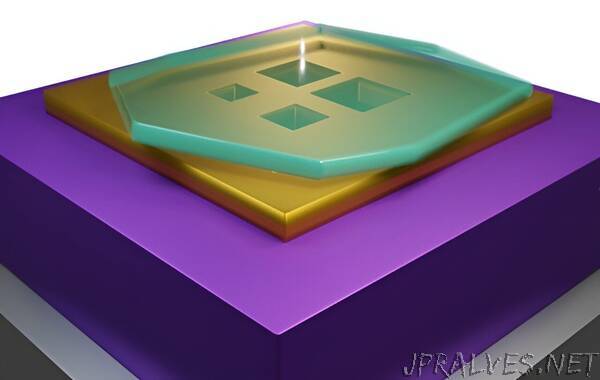
“In a significant leap forward for quantum nanophotonics, a team of European and Israeli physicists has introduced a new type of polaritonic cavities and redefined the limits of light confinement. This pioneering work, detailed in a study published in Nature Materials, demonstrates an unconventional method to confine photons, overcoming the traditional limitations in nanophotonics and simultanously achieving small volume and long lifetime photon confinement.
February 12, 2024
Physicists have long been seeking ways to force photons into increasingly small volumes. The natural length scale of the photon is the wavelength and when a photon is forced into a cavity much smaller than its wavelength, it effectively becomes more “concentrated”. This concentration enhances interactions with electrons, amplifying quantum processes within the cavity.
However, despite the immense experimental success over the last decades, the effect of dissipation (optical absorption) remains a major obstacle in confining light to extremely small volumes. Photons in nanocavities are absorbed very quickly, often even before the photon reaches from one side of the cavity to the other. This dissipation limits the applicability of nanocavities to some of the most exciting applications in quantum electrodynamics.
The research group of ICREA Prof. at ICFO Frank Koppens has published a study in Nature Materials where they overcome this challenge by creating multimodal-enhanced cavities (MEC) with an unparalleled combination of subwavelength volume and extended lifetime. These nanocavities, measuring smaller than 100x100nm² in area and only 3nm thin, confine light for significantly longer durations. The key lies in the use of hyperbolic-phonon-polaritons, unique electromagnetic excitations native to the 2D materials used to form the cavity. These hyperbolic polaritons are similar to ordinary light in most respects, but can be confined to extremely small volumes (much smaller than the wavelength cubed) in ways which defy the common intuition in optics.
When experiments outperformed the theoretical expectations
This discovery began with a chance observation made during a completely different project. While using a nearfield optical microscope to characterize a 2D material structure, the researchers noticed an unusually strong reflection when polaritons excited inside it hit the edge of a metallic substrate. This unexpected observation, at first sight anecdotal, turned out to be the underlying principle of a groundbreaking device.
The researchers figured out they could potentially use this newly discovered property to make nanocavities with high quality and small volume simultaneously, an achievement which until now eluded the nanophotonics community. The expectations were to obtain a slight improvement with respect to previous nanocavities, but when looking into the experimental measurements the team was in for a big surprise. The performance of the cavities doubled their expectations, exceeding the maximum predicted by the initial theoretical model. Even better, the nanocavities showed these relatively long lifetimes despite their reduced size (of the order of few nanometers).
“Experimental measurements are usually worse than theory would suggest, but in this case, we found the experiments outperformed the optimistic simplified theoretical predictions,” said first author, Dr. Hanan Herzig Sheinfux, from Bar-Ilan University’s Department of Physics. “This unexpected success paves the way to novel applications and advancements in quantum photonics, pushing the boundaries of what we thought was possible.”
In fact, their MEC cavities were orders of magnitude smaller than any other optical resonator of comparable lifetime. However, their enormous achievement became their biggest challenge as well, as a theoretical explanation was still lacking. After months of study, they found out that “some really beautiful and surprisingly deep physics related to nano-ray formation and multimodal interaction was the responsible of it all”, explains Dr. Herzig.
Multimodal-enhanced cavity of hyperbolic polaritons
The success of their nanocavities relied on a unique confinement mechanism as well as on the construction of the device. The nanocavities were crafted by drilling nanoscale holes in a gold substrate with the extreme (2-3 nanometer) precision of an He-focused ion beam microscope. After making the holes, hexagonal boron nitride (hBN), a 2D material that can support the hyperbolic phonon polaritons, was transferred on top of it. Light was meant to be confined inside the hBN in the region above the holes.
In the original model used to analyze the experiments, the confinement in the cavity can be likened to the increase in car traffic that occurs when a double lane expressway narrows down to a single lane. The incompatibility between the single and double lane traffic is forcing cars to congest, which is loosely similar to how light is reflected and confined when the substrate type changes at the edge of the hole into the gold substrate. The incompatibility between the suspended hBN and the hBN on gold acts as a “bottle neck” for polaritons, and light inside the cavity has a harder time leaking out.
However, as mentioned earlier, this simple model was unable to fully explain the experimental results. To do so, it turns out one needs to consider that hBN polaritons are a form of light-wave and that, unlike classical particles (like cars on a highway), they can be combined and interfere in complicated ways. Specifically, hBN polaritons can combine into multimodal ray-like excitations. The multimodal excitations that form above the nanoholes in the metal are even more incompatible with the polaritons outside of the hole, leading to an even greater degree of confinement than otherwise possible.
Crucially, this method thus avoids shaping the hBN directly and preserves its pristine quality, enabling highly-confined AND long-lived photons in the cavity.
Prof. Koppens and Dr. Herzig intend to use these cavities as a novel platform for quantum light-matter interaction experiments in order to see quantum effects that were previously thought impossible, as well as to further study the intriguing and counterintuitive physics of hyperbolic phonon polariton behavior.
Bibliographic reference:
Hanan Herzig Sheinfux et al, High-quality nanocavities through multimodal confinement of hyperbolic polaritons in hexagonal boron nitride, Nature Materials (2024). www.nature.com/articles/s41563-023-01785-w “
